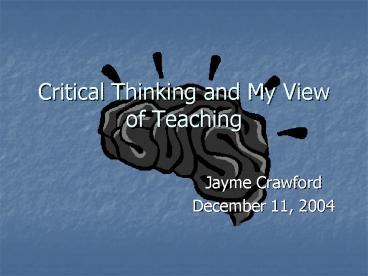Critical Thinking and My View of Teaching PowerPoint PPT Presentation
1 / 21
Title: Critical Thinking and My View of Teaching
1
Critical Thinking and My View of Teaching
- Jayme Crawford
- December 11, 2004
2
Why?
Why?
Why?
Why?
Why?
Why?
Why?
Why?
WHY?
Why?
Why?
Why?
Why?
Why?
Why?
Why?
Why?
Why?
Why?
Why?
3
On the agenda
- What influenced me?
- What is Critical Thinking?
- Professional Development and Critical Thinking
- Improving and evaluating professional development
using critical thinking - Schoolwide Professional Development
- Students and Critical Thinking
- Critical thinking and the curriculum, practice,
and evaluation - Brainiacs!
4
My influences
Critical Pedagogy Critical Thinking
5
- Critical thinking is reasonable reflective
thinking that is focused on deciding what to
believe or do. - (Ennis, 1987, p. 8)
6
Critical Thinking
- Set of dispositions and skills
- Includes higher order thinking skills
- Analysis, synthesis, evaluation from Blooms
taxonomy - The Critical Spirit
- Teaching students how to think not what to
think
7
Twelve Aspects of Critical Thinking
- Grasping the meaning of a statement
- Judging whether there is ambiguity in a line of
reasoning - Judging whether certain statements contradict
each other - Judging whether a conclusion follows necessarily
- Judging whether a statement is specific enough
- Judging whether a statement is actually the
application of a certain principle - Judging whether an observation statement is
reliable - Judging whether an inductive conclusion is
warranted - Judging whether the problem has been identified
- Judging whether something is an assumption
- Judging whether a definition is adequate
- Judging whether a statement made by an alleged
authority is acceptable - (Hoagland, 1995, p. 7)
8
- The ideal critical thinker is habitually
inquisitive, well-informed, trustful of reason,
open-minded, flexible, fair-minded in evaluation,
honest in facing personal biases, prudent in
making judgments, willing to reconsider, clear
about issues, orderly in complex matters,
diligent in seeking relevant information,
reasonable in the selection of criteria, focused
on inquiry, and persistent in seeking results
which are as precise as the subject and the
circumstances permit. - (Facione, 1990, cited in Facione, Sanchez,
Facione, and Gainen, 1995, p. 3)
9
What critical thinking is not
- Monty Python and the Holy Grail
10
Professional Development and Critical Thinking
- The mission of professional development is to
prepare and support educators to help all
students achieve higher standards of learning and
development. - (United States Department of Educations
Professional Development Team, 2000)
11
Traits of Effective Professional Development
- Self-directed
- Meaningful
- Focused on curricular goals
- Co-operative
- Sustained
12
Using critical thinking to lead professional
development
- Formulate a focused question
- Decide on the evaluation of possible answers
- Discussion further clarification, analyzing
arguments - Open-mindedness and sensitivity to other
viewpoints
?
13
Leading PD cont.
- Judge the credibility of sources of professional
development - Sources
- Expertise
- Use of established procedures
- Reputation
- Ability to give reasons
14
Leading PD cont.
- Value judgments to choose effective plan
- Examine the background of a course of action
- Consequences
- Further look at alternatives
- Deciding on a course of action
15
Leading PD cont.
- Implement the plan
- Monitor the effectiveness
- Make changes as needed
- Sustain action and goals
16
Students and Critical Thinking
- Curriculum
- Teacher questioning
- Where can I include critical thinking?
- What is the reason behind this topic being
included? - Student questioning
- Why are we learning this?
- When are we ever going to need this?
17
Students cont.
- Teaching Methods (integrated and stand alone)
- Community of inquiry
- Socratic questioning
- Case studies
18
Students cont.
- Evaluation
- Multiple choice tests with written response to
each question - Essays
- Performance assessment rubrics
19
Braniacs Would you have chosen the same 20 words
as this student?
20
I want to teach students how to think and not
what to think, and now I have the tools to do
so!
21
Presentation References
Ennis, R.H. (1987). A taxonomy of critical
thinking dispositions and abilities. In
J.B., Baron. R.J. Sternberg (Eds.) Teaching
thinking skills Theory and practice (pp.
7-26). New York W.H. Freeman and
Company. Hoaglund, J. (1995). Landmarks in
critical thinking series Ennis on the
concept of critical thinking. Inquiry Critical
Thinking Across the Disciplines, 15(2),
1-19. United States Department of Educations
Professional Development Team. (2000).
Building Bridges The Mission Principles of
Professional Development. Retrieved January 23,
2003 from http//www.ed.gov/G2K/bridge.html.
As well as all those that were included in the
original paper that inspired sections of this
presentation.

